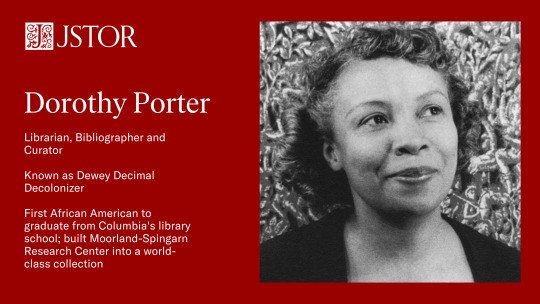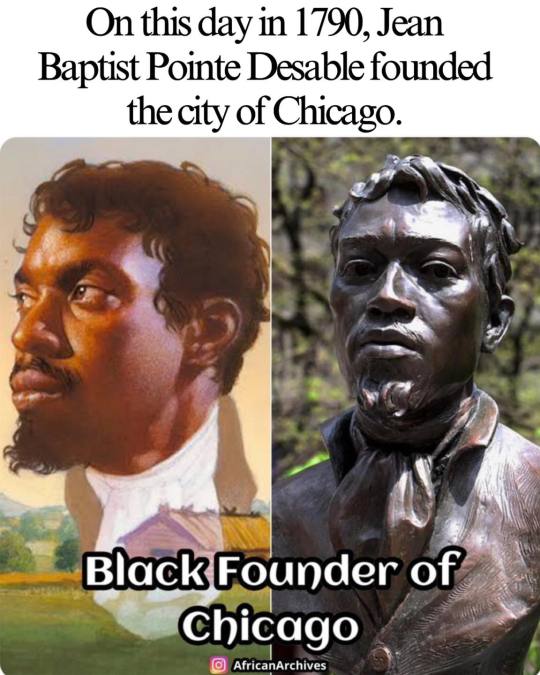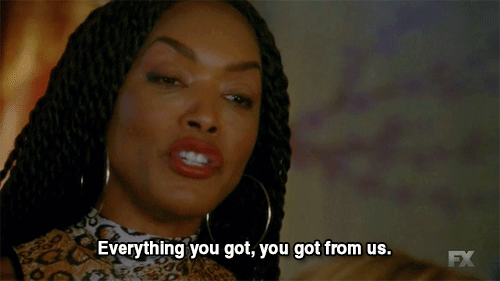#african American history
Text

Dorothy Porter is known as the "Dewey Decimal Decolonizer."
Dorothy Porter was an African American librarian who worked to challenge and decolonize library systems, including the Dewey Decimal System, which traditionally marginalized non-Western perspectives and cultures. She advocated for more inclusive classification systems that better represented diverse voices and histories.
Porter's work emphasized the importance of equity and representation within library collections, aiming to create spaces that reflect the richness and complexity of human experiences. Her efforts have contributed to ongoing discussions and actions toward decolonizing library practices worldwide.
Read more about Dorothy Porter here.
2K notes
·
View notes
Text

Jean-Baptiste Pointe DuSable was born in Saint-Domingue, Haiti (French colony) during the Haitian Revolution. At some point he settled in the part of North America that is now known as the city of Chicago and was described in historical documents as "a handsome negro"
He married a Native American woman, Kitiwaha, and they had two children. In 1779, during the American Revolutionary War, he was arrested by the British on suspicion of being an American Patriot sympathizer.
In the early 1780s he worked for the British lieutenant-governor of Michilimackinac on an estate at what is now the city of St. Clair, Michigan north of Detroit.
In the late 1700's, Jean-Baptiste was the first person to establish an extensive and prosperous trading settlement in what would become the city of Chicago. Historic documents confirm that his property was right at the mouth of the Chicago River.
Many people, however, believe that John Kinzie (a white trader) and his family were the first to settle in the area that is now known as Chicago, and it is true that the Kinzie family were Chicago's first "permanent" European settlers.
But the truth is that the Kinzie family purchased their property from a French trader who had purchased it from Jean-Baptiste.
He died in August 1818, and because he was a Black man, many people tried to white wash the story of Chicago's founding. But in 1912, after the Great Migration, a plaque commemorating Jean-Baptiste appeared in downtown Chicago on the site of his former home.
Later in 1913, a white historian named Dr. Milo Milton Quaife also recognized Jean-Baptiste as the founder of Chicago.
And as the years went by, more and more Black notables such as Carter G. Woodson and Langston Hughes began to include Jean-Baptiste in their writings as "the brownskin pioneer who founded the Windy City."
In 2009, a bronze bust of Jean-Baptiste was designed and placed in Pioneer Square in Chicago along the Magnificent Mile.
There is also a popular museum in Chicago named after him called the DuSable Museum of African American History.
x
#Jean-Baptiste Pointe DuSable#Haitian Revolution#Chicago history#founder of Chicago#black history#Native American wife#Kitiwaha#American Revolutionary War#British arrest#Michilimackinac#St. Clair Michigan#trading settlement#Chicago River#John Kinzie#European settlers#Great Migration#Carter G. Woodson#Langston Hughes#Windy City#bronze bust#Pioneer Square#Magnificent Mile#DuSable Museum#African American history
557 notes
·
View notes
Text

I have given the world my songs. Elizabeth Catlett. 1947.
West Harlem Art Fund
#elizabeth catlett#african american artists#guitar#musicians#prints#blue#racism#cross burning#african american history#black artists#nemfrog#1947#1940s
490 notes
·
View notes
Text

For the ppl in the back!!
#black tumblr#black history#black literature#black excellence#black community#civil rights#black history is american history#civil rights movement#equality#equal rights#black lives matter#black pride#black people#equal#african slavery#american slavery#african american history#american history
2K notes
·
View notes
Text

Black history: Did you know?
Phillis Wheatley was only 12 when she became the first female African American author published.
Despite Phyllis Wheatley’s fame, we know surprisingly little about her early life. She was taken from her home in Africa when she was seven or eight, and sold to the Wheatley family in Boston. The family taught her to read and write, and encouraged her to write poetry as soon as they witnessed her talent for it. In 1773, Phyllis published her first poem, making her the first African American to be published. She was only 12 at the time.
Read more: https://www.poetryfoundation.org/poets/phillis-wheatley
#black excellence#black and proud#black americans#black history#black woman#black history month#black tumblr#black women#african america history#african american history
508 notes
·
View notes
Text
Beyond the Stars: Mae Jemison’s Odyssey ✨

Happy Black History Month!
This Black History Month, we spotlight the extraordinary life of Dr. Mae Jemison, the first African American woman to travel in space. Born on October 17, 1956, in Decatur, Alabama, and raised in Chicago, Illinois, Jemison’s journey into the stars is a testament to the power of dreams and determination.

From an early age, Jemison showed a keen interest in science and space, but noticed the absence of women astronauts. She pursued her passion relentlessly, earning a B.S. in Chemical Engineering from Stanford University and an M.D. from Cornell Medical College. Before joining NASA, Jemison was a general practitioner and served in the Peace Corps in Sierra Leone and Liberia, where she managed health care for other volunteers.
In 1987, Jemison’s dream became reality when she was selected for NASA’s astronaut program. On September 12, 1992, aboard the Space Shuttle Endeavor on mission STS-47, Jemison became the first African American woman to travel in space, serving as a mission specialist. During her eight-day mission, she conducted experiments on weightlessness and motion sickness, contributing valuable data to the field.

Jemison’s honors include induction into the National Women’s Hall of Fame, the National Medical Association Hall of Fame, and the Texas Science Hall of Fame, among others. Her story is not just one of breaking barriers in space exploration, but also of inspiring generations to pursue their dreams, regardless of birth and obstacles.

For more information on Mae Jemison’s groundbreaking journey and contributions to science and humanity, the National Archives holds numerous resources that illuminate the lives and achievements of African American pioneers:
371 notes
·
View notes
Text

#blm#discrimination#defund the police#bipoc#black lives matter#civil rights#black lives fucking matter#lgbtqia#black lives movement#black lives have always mattered#black lives are important#black history#lgbtq#black liberation#african american history#civil rights movement#black community#civil war#civil liberties#black history month#black pride#black culture#black archives#black excellence
830 notes
·
View notes
Text

Letter from Andrew S. Evans to President Harry S. Truman
Collection HST-OFF: Official Files (Truman Administration)Series: Official FilesFile Unit: Segregation, July 1948-June 1949, OF 93b
3228-Hiatt Pl. N.W.
Wash; 10, DC
June 20, 1949
Dear Mr. President,
I live about three yards from a white playground, yet it is a public school playground. I am a colored boy and not allowed to go on it. All the white boys enjoy playing with me. But I am put off by the adult managers. I am writing you for a consideration because my playground is 4 or 5 blocks away. My parents are afraid of me being hit by cars. I am eleven yrs. old. Please answer.
Sincerely,
Andrew S. Evans
[added by hand in pencil "6 child's letter" "93-B" 'X93 miscel"]
149 notes
·
View notes
Text

#african americans rights#african american history#underground railroad#slavery#civil war#black lives matter#civil rights movement#the narrative of the live of frederick douglass#frederick douglass#fourth of july
692 notes
·
View notes
Text

1924, A family in Harlem, New York City, photo by James Van Der Zee
#african#afrakan#kemetic dreams#brownskin#afrakans#africans#brown skin#african culture#african american#african american history#harlem#new york city#james van der zee
507 notes
·
View notes
Text
Stop correcting southerners . It’s very anti black . A Lot of AAVE or Ebonics come from the south . Respect it . There is no proper way to speak
#AAVE#Ebonics#black power#knowledge#black knowledge#language#English#african american#african american history
1K notes
·
View notes
Text

#black republicans#progressive ideas#historical context#modern politics#affirmative action#public financing of education#anti-black worldview#white supremacy#political policies#african american history#political alignment#black leadership#historical black republicans#political dynamics#modern black republicans#political representation#racial dynamics in politics#black political history#republican party#white approval#policy priorities#african american leaders#black conservatives#historical vs modern republicans#black community interests#political shifts#racial justice#political critique
663 notes
·
View notes
Text

This makes Tiana the Princess of Creole Cuisine!
🍽️👩🏾🦱👑
#history#princess tiana#leah chase#juneteenth#new orleans#african american history#disney#princess and the frog#united states#1950s#womens history#1960s#disney princess#animation#creole#soft girl#girl power#tiana's bayou adventure#disney history#black femininity#american history#civil rights#dooky chase#princesscore#black girl magic#historical figures#food history#landmark#nickys facts
115 notes
·
View notes
Text

#black panther party#black panthers#black history#black tumblr#black literature#black excellence#black community#civil rights#black history is american history#civil rights movement#black girl magic#blackexcellence365#equal rights#black lives matter#black history matters#african american history#american history#american#black history month#black history facts
1K notes
·
View notes
Text
Hoodoo, Rootwork and Conjure sources by Black Authors
Because you should only ever be learning your ancestral ways from kinfolk. Here's a compilation of some books, videos and podcast episodes I recommend reading and listening to, on customs, traditions, folk tales, songs, spirits and history. As always, use your own critical thinking and spiritual discernment when approaching these sources as with any others.

Hoodoo in America by Zora Neale Hurston (1931)
Mules and Men by Zora Neale Hurston (1936)
Tell my horse by Zora Neale Hurston (1938)
Let Nobody Turn Us Around: An African American Anthology by Manning Marable and Leith Mullings, editors (2003)
Black Magic: Religion and the African American Conjuring Tradition by Yvonne P. Chireau (2006)
African American Folk Healing by Stephanie Mitchem (2007)
Hoodoo Medicine: Gullah Herbal Remedies by Faith Mitchell (2011)
Mojo Workin': The Old African American Hoodoo System by Katrina Hazzard-Donald (2012)
Rootwork: Using the Folk Magick of Black America for Love, Money and Success by Tayannah Lee McQuillar (2012)
Talking to the Dead: Religion, Music, and Lived Memory among Gullah/Geechee Women by LeRhonda S. Manigault-Bryant (2014)
Working the Roots: Over 400 Years Of Traditional African American Healing by Michele Elizabeth Lee (2017)
Barracoon: The Story of the Last "Black Cargo" by Zora Neale Hurston (2018)
Jambalaya: The Natural Woman's Book of Personal Charms and Practical Rituals by Luisa Teish (2021)
African American Herbalism: A Practical Guide to Healing Plants and Folk Traditions by Lucretia VanDyke (2022)
youtube
youtube
youtube
youtube
These are just some suggestions but there's many many more!! This is by no means a complete list.
I recommend to avoid authors who downplay the importance of black history or straight out deny how blackness is central to hoodoo. The magic, power and ashé is in the culture and bloodline. You can't separate it from the people. I also recommend avoiding or at the very least taking with a huge grain of salt authors with ties to known appropriators and marketeers, and anyone who propagates revisionist history or rather denies historical facts and spreads harmful conspiracy theories. Sadly, that includes some black authors, particularly those who learnt from, and even praise, white appropriators undermining hoodoo and other african and african diasporic traditions. Be careful who you get your information from. Keeping things traditional means honoring real history and truth.
Let me also give you a last but very important reminder: the best teachings you'll ever get are going to come from the mouths of your own blood. Not a book or anything on the internet. They may choose to put certain people and things in your path to help you or point you in the right direction, but each lineage is different and you have to honor your own. Talk to your family members, to the Elders in your community, learn your genealogy, divine before moving forwards, talk to your dead, acknowledge your people and they'll acknowledge you and guide you to where you need to be.
May this be of service and may your ancestors and spirits bless you and yours 🕯️💀
#hoodoo#conjure#rootwork#black hoodoo authors#Youtube#hoodoo books#african american conjure#african american history#black history#black folklore#african american folklore#black magic#african american magic#witches of color#ATRs#Spotify
1K notes
·
View notes
Text

Black History Month: Did you know?
The three-light traffic signal was invented by a Black man named Garrett Morgan.
Garrett Morgan had only an elementary school education and was the son of a formerly enslaved man. Nevertheless, Morgan surmounted these difficulties and is responsible for many important inventions. Most notably, Morgan invented the three-light traffic signal in 1923.
While driving one day, Morgan witnessed a serious car crash at an intersection. This sparked his idea to add a third light to the traffic signal which would warn drivers of an impending red light. His patent was granted in 1924, and after early installments of the three-light traffic signal were successful, they spread throughout the country and became the three-light signal many of us encounter daily.
#black history matters#black excellence#black americans#black history#black history month#black tumblr#african america history#african american history
266 notes
·
View notes